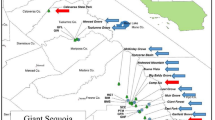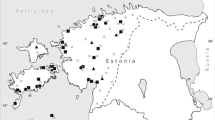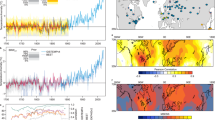Abstract
Cool-season precipitation is a critical component of western North American water supplies. In recent decades, snow water equivalent (snowpack) has declined dramatically, culminating in record lows along the northern Cascade Range, USA, during the winters of 2014 and 2015. Given the brevity of observational records, the extent to which these recent trends exceed historical ranges of variability remains poorly understood. Here, we use a network of 30 tree-ring chronologies to reconstruct April 1 snowpack in the northern Cascade Mountains (Washington, USA) over the past ca. 400 years that accounts for 62% of the instrumental period variability. The reconstruction is characterized by considerable interannual- to interdecadal-scale variability. Yet, the most conspicuous feature is a decline that began in the mid-1970s concurrent with a shift to above-average air temperature which is accelerated through to the most recent years of the record. The 2014–2016 snow drought, especially snow conditions during the 2015 winter, across the northern Cascades is unprecedented within the context of the last 400 years. The reconstruction is characterized by considerable interannual- to interdecadal-scale variability, but a conspicuous decline emerged in the mid-1970s and accelerated through to the most recent years of the record to levels below the pre-industrial envelope of variability. This decline culminated in the 2014–2016 northern Cascade Mountains snow drought, which is unprecedented within the context of the last 400 years. Not only is the twentieth–twenty-first century period characterized by the rapid decline in snowpack conditions, it is also highly volatile. Extreme flips in snowpack conditions (year-to-year changes between < 5th and > 95th percentiles) during the twentieth and twenty-first centuries were anomalous within the context of the record. These patterns described for the North Cascades are concurrent with anomalously low snowpack in the Sierra Nevada Mountains of California, and thus part of a broader trend toward reduced snowpack in western North America. This decline will fundamentally impact regional drought and hydrography in North Cascadia and is likely the combined result of rising temperatures, weakening






Similar content being viewed by others
References
Abatzoglou JT, Williams AP (2016) Impact of anthropogenic climate change on wildfire across western us forests. Proc Natl Acad Sci 113(42):11770–11775
Akaike H (1974) A new look at the statistical model identification. In: Selected papers of Hirotugu Akaike. Springer, pp 215–222
Balch JK, Bradley BA, Abatzoglou JT, Nagy RC, Fusco EJ, Mahood AL (2017) Human-started wildfires expand the fire niche across the united states. Proc Natl Acad Sci 114(11):2946–2951
Bales RC, Molotch NP, Painter TH, Dettinger MD, Rice R, Dozier J (2006) Mountain hydrology of the western united states. Water Resour Res 42:8
Barnett T, Adam Y, Lattermaier C (2008) Potential impact of a warm climate on water availability in a snow dominated region
Bekker MF, Justin DeRose R, Buckley BM, Kjelgren RK, Gill NS (2014) A 576-year weber river streamflow reconstruction from tree rings for water resource risk assessment in the wasatch front, Utah. JAWRA J Am Water Resour Assoc 50 (5):1338–1348
Belmecheri S, Babst F, Wahl ER, Stahle DW, Trouet V (2016) Multi-century evaluation of Sierra Nevada snowpack. Nat Clim Change 6(1):2
Black BA, Sydeman WJ, Frank DC, Griffin D, Stahle DW, García-Reyes M, Rykaczewski RR, Bograd SJ, Peterson WT (2014) Six centuries of variability and extremes in a coupled marine-terrestrial ecosystem. Science 345(6203):1498–1502
Black BA, van der Sleen P, Di Lorenzo E, Griffin D, Sydeman WJ, Dunham JB, Rykaczewski RR, García-Reyes M, Safeeq M, Arismendi I et al (2018) Rising synchrony controls western north american ecosystems. Global Change Biol 24(6):2305–2314
Bond NA, Cronin MF, Freeland H, Mantua N (2015) Causes and impacts of the 2014 warm anomaly in the ne pacific. Geophys Res Lett 42(9):3414–3420
Cook ER, Peters K (1981) The smoothing spline: a new approach to standardizing forest interior tree-ring width series for dendroclimatic studies
Cook ER, Meko DM, Stahle DW, Cleaveland MK (1999) Drought reconstructions for the continental united states. J Climate 12(4):1145–1162
Cook ER, Woodhouse CA, Eakin CM, Meko DM, Stahle DW (2004) Long-term aridity changes in the western united states. Science 306(5698):1015–1018
Cook ER, Seager R, Cane MA, Stahle DW (2007) North American drought: reconstructions, causes, and consequences. Earth-Sci Rev 81(1-2):93–134
Cook BI, Miller RL, Seager R (2008) Dust and sea surface temperature forcing of the 1930s “dust bowl” drought. Geophys Res Lett 35:8
Cook ER, Palmer JG, Ahmed M, Woodhouse CA, Fenwick P, Zafar MU, Wahab M, Khan N (2013) Five centuries of upper indus river flow from tree rings. J Hydroly 486:365–375
Cooper MG, Nolin AW, Safeeq M (2016) Testing the recent snow drought as an analog for climate warming sensitivity of cascades snowpacks. Environ Res Lett 11 (8):084009
Coulthard B, Smith DJ, Meko DM (2016) Is worst-case scenario streamflow drought underestimated in British Columbia? A multi-century perspective for the South Coast, derived from tree-rings. J Hydrol 534:205–218
Dettinger MD, Cayan DR (1995) Large-scale atmospheric forcing of recent trends toward early snowmelt runoff in california. J Climate 8(3):606–623
Flanner MG, Shell KM, Barlage M, Perovich DK, Tschudi M (2011) Radiative forcing and albedo feedback from the northern hemisphere cryosphere between 1979 and 2008. Nat Geosci 4(3):151
Fritts H (1976) Tree rings and climate. Elsevier
Graumlich LJ (1987) Precipitation variation in the pacific northwest (1675–1975) as reconstructed from tree rings. Ann Assoc Am Geogr 77(1):19–29
Graumlich LJ, Brubaker LB (1986) Reconstruction of annual temperature (1590–1979) for longmire, Washington, derived from tree rings. Quatern Res 25 (2):223–234
Griffin D, Woodhouse CA, Meko DM, Stahle DW, Faulstich HL, Carrillo C, Touchan R, Castro CL, Leavitt SW (2013) North american monsoon precipitation reconstructed from tree-ring latewood. Geophys Res Lett 40(5):954–958
Guttman L (1954) Some necessary conditions for common-factor analysis. Psychometrika 19(2):149–161
Hansen-Bristow K (1986) Influence of increasing elevation on growth characteristics at timberline. Can J Bot 64(11):2517–2523
Harpold AA, Brooks PD (2018) Humidity determines snowpack ablation under a warming climate. Proc Natl Acad Sci 115(6):1215–1220
Harley GL, Maxwell JT (2018) Current declines of pecos river (New Mexico, USA) streamflow in a 700-year context. The Holocene 28(5):767–777
Harley GL, Maxwell JT, Larson E, Grissino-Mayer HD, Henderson J, Huffman J (2017) Suwannee river flow variability 1550–2005 ce reconstructed from a multispecies tree-ring network. J Hydrol 544:438–451
Hart SJ, Smith DJ, Clague JJ (2010) A multi-species dendroclimatic reconstruction of chilko river streamflow, British Columbia, Canada. Hydrol Process 24 (19):2752–2761
Hauer FR, Baron JS, Campbell DH, Fausch KD, Hostetler SW, Leavesley GH, Leavitt PR, McKnight DM, Stanford JA (1997) Assessment of climate change and freshwater ecosystems of the rocky mountains, usa and canada. Hydrol Process 11 (8):903–924
Holmes R (1983) Program cofecha user’s manual laboratory of tree-ring research. The University of Arizona, Tucson
Kaiser HF (1960) The application of electronic computers to factor analysis. Educ Psychol Measur 20(1):141–151
Lean J (2000) Evolution of the sun’s spectral irradiance since the maunder minimum. Geophys Res Lett 27(16):2425–2428
Littell JS, McKenzie D, Peterson DL, Westerling AL (2009) Climate and wildfire area burned in western us ecoprovinces, 1916–2003. Ecol Appl 19(4):1003–1021
Loecke TD, Burgin AJ, Riveros-Iregui DA, Ward AS, Thomas SA, Davis CA, Clair MAS (2017) Weather whiplash in agricultural regions drives deterioration of water quality. Biogeochemistry 133(1):7–15
Luckman B, Wilson R (2005) Summer temperatures in the canadian rockies during the last millennium: a revised record. Climate Dynam 24(2–3):131–144
Mantua NJ (2015) Shifting patterns in pacific climate, west coast salmon survival rates, and increased volatility in ecosystem services. Proc Natl Acad Sci 112 (35):10823–10824
Margolis EQ, Meko DM, Touchan R (2011) A tree-ring reconstruction of streamflow in the santa fe river, new mexico. J Hydrol 397(1–2):118–127
Maxwell RS, Harley GL, Maxwell JT, Rayback SA, Pederson N, Cook ER, Barclay DJ, Li W, Rayburn JA (2017) An interbasin comparison of tree-ring reconstructed streamflow in the Eastern United States. Hydrol Process 31 (13):2381–2394
McCabe GJ, Wolock DM (2002) Trends and temperature sensitivity of moisture conditions in the conterminous united states. Climate Res 20(1):19–29
Meko DM, Woodhouse CA, Baisan CA, Knight T, Lukas JJ, Hughes MK, Salzer MW (2007) Medieval drought in the upper Colorado river basin. Geophys Res Lett 34:10
Melvin T, Briffa K (2008) A ‘signal-free’ approach to dendroclimatic standardisation. Dendrochronologia 26(2):71–86
Mote PW (2003) Trends in snow water equivalent in the pacific northwest and their climatic causes. Geophys Res Lett 30:12
Mote PW, Hamlet AF, Clark MP, Lettenmaier DP (2005) Declining mountain snowpack in western north america. Bull Am Meteorol Soc 86(1):39–50
Mote PW, Rupp DE, Li S, Sharp DJ, Otto F, Uhe PF, Xiao M, Lettenmaier DP, Cullen H, Allen MR (2016) Perspectives on the causes of exceptionally low 2015 snowpack in the western United States. Geophys Res Lett 43 (20):10–980
Oliver JS, Harley GL, Maxwell JT (2019) 2,500 years of hydroclimate variability in New Mexico, USA. Geophys Res Lett 46(8):4432–4440
Pederson GT, Graumlich LJ, Fagre DB, Kipfer T, Muhlfeld CC (2010) A century of climate and ecosystem change in western montana: what do temperature trends portend? Clim Change 98(1–2):133–154
Pederson GT, Gray ST, Woodhouse CA, Betancourt JL, Fagre DB, Littell JS, Watson E, Luckman BH, Graumlich LJ (2011) The unusual nature of recent snowpack declines in the North American Cordillera. Science 333(6040):332–335
Perkins DL, Swetnam TW (1996) A dendroecological assessment of whitebark pine in the sawtooth–salmon river region, Idaho. Can J Forest Res 26(12):2123–2133
Peterson DW, Peterson DL (1994) Effects of climate on radial growth of subalpine conifers in the north cascade mountains. Can J Forest Res 24(9):1921–1932
Regonda SK, Rajagopalan B, Clark M, Pitlick J (2005) Seasonal cycle shifts in hydroclimatology over the Western United States. J Clim 18(2):372–384
Salzer MW, Kipfmueller KF (2005) Reconstructed temperature and precipitation on a millennial timescale from tree-rings in the southern colorado plateau, USA. Clim Change 70(3):465–487
Schubert SD, Suarez MJ, Pegion PJ, Koster RD, Bacmeister JT (2004) On the cause of the 1930s dust bowl. Science 303(5665):1855–1859
Sheppard PR, Comrie AC, Packin GD, Angersbach K, Hughes MK (2002) The climate of the us southwest. Climate Res 21(3):219–238
Speer JH (2010) Fundamentals of tree-ring research. University of Arizona Press
Sproles EA, Roth TR, Nolin AW (2017) Future snow? A spatial-probabilistic assessment of the extraordinarily low snowpacks of 2014 and 2015 in the oregon cascades. Cryosphere 11(1):331
Stahle DW, Cleaveland MK, Grissino-Mayer HD, Griffin RD, Fye FK, Therrell MD, Burnette DJ, Meko DM, Villanueva Diaz J (2009) Cool-and warm-season precipitation reconstructions over Western New Mexico. J Climate 22 (13):3729–3750
Starheim CC, Smith DJ, Prowse TD (2013) Dendrohydroclimate reconstructions of july–august runoff for two nival-regime rivers in West Central British Columbia. Hydrol Process 27(3):405–420
Stewart IT, Cayan DR, Dettinger MD (2005) Changes toward earlier streamflow timing across Western North America. J Clim 18(8):1136–1155
Stockton CW, Jacoby GC (1976) Long-term surface water supply and streamflow levels in the upper Colorado river basin. Lake powell research project. Bulletin 18:70
Stockton CW, Meko DM (1975) A long-term history of drought occurrence in western United States as inferred from tree rings. Weatherwise 28(6):244–249
Swain DL, Langenbrunner B, Neelin JD, Hall A (2018) Increasing precipitation volatility in twenty-first-century California. Nat Clim Change 8(5):427
Vinod HD, López-de Lacalle J, et al. (2009) Maximum entropy bootstrap for time series: the meboot r package. J Stat Softw 29(5):1–19
Watson E, Luckman BH (2016) An investigation of the snowpack signal in moisture-sensitive trees from the Southern Canadian Cordillera. Dendrochronologia 38:118–130
Westerling AL, Hidalgo HG, Cayan DR, Swetnam TW (2006) Warming and earlier spring increase western us forest wildfire activity. Science 313(5789):940–943
Wigley TML, Briffa KR, Jones PD (1984) On the average value of correlated time series, with applications in dendroclimatology and hydrometeorology. J Clim Appl Meteorol 23:201–213
Wilson RJ, Luckman BH (2003) Dendroclimatic reconstruction of maximum summer temperatures from upper treeline sites in interior British Columbia, Canada. The Holocene 13(6):851–861
Wilson R, Rao R, Rydval M, Wood C, Larsson LÅ, Luckman BH (2014) Blue intensity for dendroclimatology: the bc blues: a case study from British Columbia, Canada. The Holocene 24(11):1428–1438
Wilson R, Anchukaitis K, Andreu-Hayles L, Cook E, D’Arrigo R, Davi N, Haberbauer L, Krusic P, Luckman B, Morimoto D et al (2019) Improved dendroclimatic calibration using blue intensity in the Southern Yukon. The Holocene p 0959683619862037
Woodhouse CA (2003) A 431-yr reconstruction of western Colorado snowpack from tree rings. J Climate 16(10):1551–1561
Woodhouse CA, Gray ST, Meko DM (2006) Updated streamflow reconstructions for the upper Colorado river basin. Water Resour Res 42:5
Woodhouse CA, Meko DM, MacDonald GM, Stahle DW, Cook ER (2010) A 1,200-year perspective of 21st century drought in Southwestern North America. Proc Natl Acad Sci 107(50):21283–21288
Woodhouse CA, Stahle DW, Díaz JV (2012) Rio grande and rio conchos water supply variability over the past 500 years. Climate Res 51(2):147–158
Acknowledgments
The inception of this paper came during the 26th annual North American Dendroecological Fieldweek (NADEF), Pack Forest, Eatonville, Washington, USA. The authors would like to thank Varun Agrawal, Nancy Calhoun, Scott Ingram, Timon Keller, Kevin Silcox, Myesa Legendre-Fixx, Carlos Montanez, Stephen Price, and Kerri Spuller for helping update the Tahoma Creek tree-ring chronology (ultimately not retained for modeling); Dr. Aquila Flower, Bess Bookout, Benjamin Hagedorn, Lacey Hankin, John Lovseth, Laura Smith, and Andy Whelan for updating the Mt. Rainier High chronology as part of the “Disturbance Ecology/Treeline Dynamics” group at NADEF; and Alan Tepley for assistance in developing the Marys Peak chronology with funding from the HJ Andrews Experimental Forest and Long Term Ecological Research program, supported by the National Science Foundation under Grant No. DEB-1440409. Finally, we thank two anonymous reviewers for giving up their time to provide comments that improved earlier drafts of this manuscript.
Author information
Authors and Affiliations
Corresponding author
Additional information
Publisher’s note
Springer Nature remains neutral with regard to jurisdictional claims in published maps and institutional affiliations.
Electronic supplementary material
Below is the link to the electronic supplementary material.
Rights and permissions
About this article
Cite this article
Harley, G.L., Maxwell, R.S., Black, B.A. et al. A multi-century, tree-ring-derived perspective of the North Cascades (USA) 2014–2016 snow drought. Climatic Change 162, 127–143 (2020). https://doi.org/10.1007/s10584-020-02719-0
Received:
Accepted:
Published:
Issue Date:
DOI: https://doi.org/10.1007/s10584-020-02719-0




